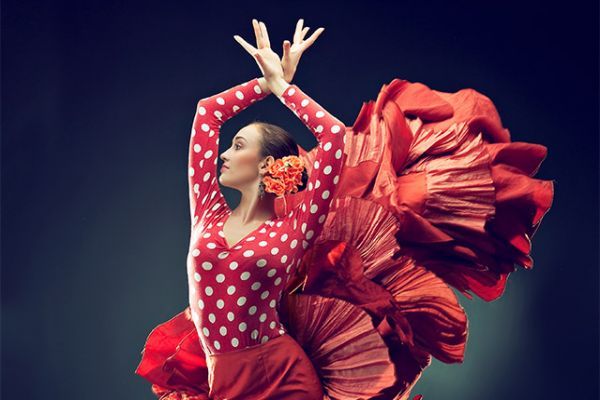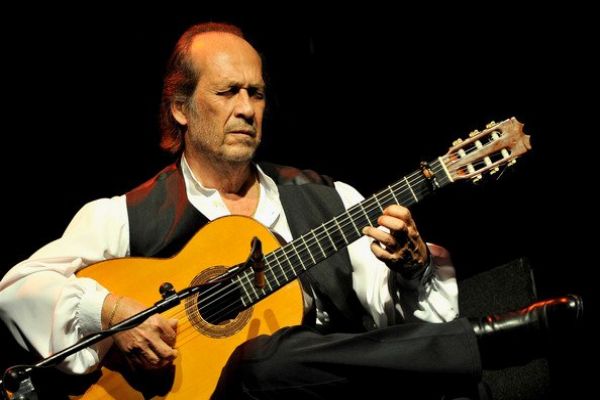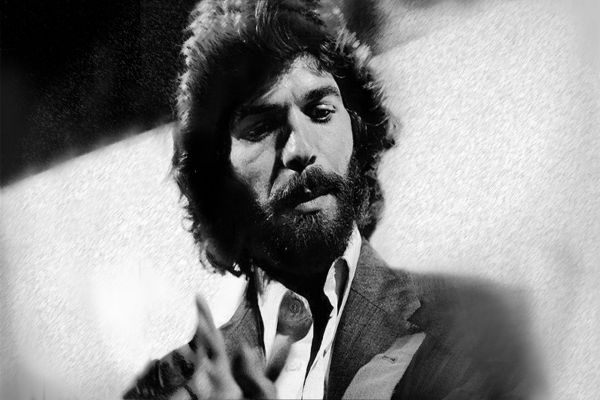 The Flamenco folklore is an Andalusian art, so their origins are in the South of Spain. This art is manifest in three different aspects: ‘el Cante’ (singing, popular song), dance and guitar. Its provenance is rather uncertain, because having very ancient roots and being a popular form of expression, doubts on its origins remain, because documentation is insufficient. The first written note on flamenco appears in one of the “Cartas Marruecas” (Moroccan letters) by Cadalso, (1774) who attributes its origins to the gypsies, and knowing that they are from the Indies, one can clearly see their influence. The gypsies have from the very beginning been the ones who kept the flamenco alive and represented it with profound dedication. Another very strong influence of flamenco is due to the Muslim epoch of Spain. Various ethnic groups from North Africa settled down mainly in Andalucia in the Early Middle Ages. Their influence can clearly be appreciated in its harmonies. The flamenco singing conserves great parallels with other musical manifestations of North Africa, such as the Moroccan music.
The Flamenco folklore is an Andalusian art, so their origins are in the South of Spain. This art is manifest in three different aspects: ‘el Cante’ (singing, popular song), dance and guitar. Its provenance is rather uncertain, because having very ancient roots and being a popular form of expression, doubts on its origins remain, because documentation is insufficient. The first written note on flamenco appears in one of the “Cartas Marruecas” (Moroccan letters) by Cadalso, (1774) who attributes its origins to the gypsies, and knowing that they are from the Indies, one can clearly see their influence. The gypsies have from the very beginning been the ones who kept the flamenco alive and represented it with profound dedication. Another very strong influence of flamenco is due to the Muslim epoch of Spain. Various ethnic groups from North Africa settled down mainly in Andalucia in the Early Middle Ages. Their influence can clearly be appreciated in its harmonies. The flamenco singing conserves great parallels with other musical manifestations of North Africa, such as the Moroccan music.
 The guitar often reminds one of the musical manifestations not only from North Africa but alsol from Black Africa. The female dance, in particular the movements of the hips and hands, are similar to those of some North African dances. All these influences cannot be denied for being notorious and do not surprise us, if we bear in mind that Andalucia had been influenced by that culture for many centuries. In addition to this, various races lived together in these lands, which may let you realize other influences in the merry Jewish folklore rhythms or their ancient liturgical music, although one does not really know, whether it is by coincidence or corresponds to reality. In whichever case the flamenco art can be regarded as pure and as crossbred at the same time.
The guitar often reminds one of the musical manifestations not only from North Africa but alsol from Black Africa. The female dance, in particular the movements of the hips and hands, are similar to those of some North African dances. All these influences cannot be denied for being notorious and do not surprise us, if we bear in mind that Andalucia had been influenced by that culture for many centuries. In addition to this, various races lived together in these lands, which may let you realize other influences in the merry Jewish folklore rhythms or their ancient liturgical music, although one does not really know, whether it is by coincidence or corresponds to reality. In whichever case the flamenco art can be regarded as pure and as crossbred at the same time.
It contains elements of its own kind that it does not have in common with any other type of folklore, but at the same time you may clearly appreciate a high amount of influence streams other peoples contributed with the result of its enrichment. We know going superficially through the evolution of the flamenco, as it is today, and based on professional investigations and documents, we can start out with an epoch not too far ago in the past between 1765 and 1860. In that period we find three important focal points that would found schools: Cádiz, Jerez de la Frontera, and the suburb of Triana in Sevilla. From that moment onwards, the flamenco dance was bound to have a firm place among the Spanish dances that were developed in schools, and often performed in patios, guest houses (roadside inns), private salons during the celebrations of feasts.
 As to the guitar, in the beginning, it did not accompany the singing. It was performed without any complementary element which led to the expression a palo seco (without ornaments), except for the percussion performed with the hands (toque de palmas). Some composers such as Julián Arcas, started to compose themes with flamenco sounds that initiated a new era. Between 1860 and 1910, we enter in the most prolific period that was to be called The Golden Age of Flamenco. In that epoch, dance cafés flourished where flamenco developed in all its facets: the instrumental facet, singing and dance; up to the point that we can definitely tie it down to the classicism of the “jondo” (profoundly Andalusian gypsy–like). The dance acquired a splendour that had never been there before, and it became the main attraction for the visitors to those song cafés. The guitar became an indispensable complement for the flamenco singing and dance.
As to the guitar, in the beginning, it did not accompany the singing. It was performed without any complementary element which led to the expression a palo seco (without ornaments), except for the percussion performed with the hands (toque de palmas). Some composers such as Julián Arcas, started to compose themes with flamenco sounds that initiated a new era. Between 1860 and 1910, we enter in the most prolific period that was to be called The Golden Age of Flamenco. In that epoch, dance cafés flourished where flamenco developed in all its facets: the instrumental facet, singing and dance; up to the point that we can definitely tie it down to the classicism of the “jondo” (profoundly Andalusian gypsy–like). The dance acquired a splendour that had never been there before, and it became the main attraction for the visitors to those song cafés. The guitar became an indispensable complement for the flamenco singing and dance.
Between 1910 and 1955, the flamenco singing was characterized by what was to be called the period of the ópera flamenca where the rather swift songs like the fandangos and cantes de ida y vuelta (those were songs of South American influence, brought here by the folk singers who had emigrated to Latin-America). Not everyone liked the new way the flamenco had taken, and in 1922, the intellectuals of the ‘Generation of 27’, Falla, and other artists, created a contest in Granada with the purpose of looking for new values that would be developing the “cante jondo auténtico“.
 From 1915 onwards, a theatre dance cycle of an exceptional quality was produced. This way, the Spanish dance and flamenco got on to the stages of the world. Renaissance of Flamenco came up from 1955 onwards with Antonio Mairena as its main figure, showing interpretative severity and his eagerness for investigation and popularisation of the orthodox form of flamenco singing. During that period, the dance developed in the tablaos, heirs of the former dance cafés. That period counted on real personalities of the dance who had their perfomance not only switching from one tablao to the other but also to theatres, festivals and other stages. The guitar players who accompanied the singing and dance acquired a more important role, and thus this art reached the point of maturity.
From 1915 onwards, a theatre dance cycle of an exceptional quality was produced. This way, the Spanish dance and flamenco got on to the stages of the world. Renaissance of Flamenco came up from 1955 onwards with Antonio Mairena as its main figure, showing interpretative severity and his eagerness for investigation and popularisation of the orthodox form of flamenco singing. During that period, the dance developed in the tablaos, heirs of the former dance cafés. That period counted on real personalities of the dance who had their perfomance not only switching from one tablao to the other but also to theatres, festivals and other stages. The guitar players who accompanied the singing and dance acquired a more important role, and thus this art reached the point of maturity.
The guitar player nowadays is not just a complement but also a soloist. Paco de Lucía represents the initial point of a new magnificent period that has no predecessors, and he is performing a real stylistic revolution in his way of playing (toque). Other truly virtuous guitarists have to be mentioned together with him, e.g. Manolo Sanlúcar. The flamenco continues its development on its way to become universal. While the contemporary flamenco music is to a great extent characterized by a mixture of other music types, such as jazz, salsa, bossa, nova, ethnic sounds of different roots and geographic regions, nowadays, we can visit shows of the most authentically pure and classical Flamenco in Andalucia, interpreted e.g. by a Japanese flamenco dancer or an Italian guitar player, and applauded by an understanding public. The Flamenco is a plainly intimate music but its culmination moves it to a new era where the mass media can witness its grace, its strength and its magic. But where you can feel it best, this will always be within a small circle of friends, where just the guitar, the voice and the dancing silhouette in the dawn can be perceived, and this is what we call “una juerga flamenca” (a gypsy celebration).






